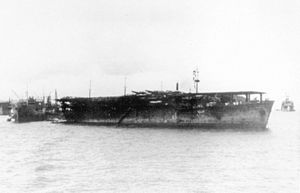Taiyō-class escort carrier

Chūyō at anchor
|
|
| Class overview | |
|---|---|
| Name: | Taiyō class |
| Operators: |
|
| Preceded by: | None |
| Succeeded by: | Kaiyo |
| Built: | 1938–41 |
| In service: | 1941–44 |
| Completed: | 3 |
| Lost: | 3 |
| General characteristics (as converted) | |
| Type: | Escort carrier |
| Displacement: |
|
| Length: | 180.2 m (591 ft 4 in) (o/a) |
| Beam: | 22.5 m (73 ft 10 in) |
| Draught: | 7.7–8.0 m (25.4–26.25 ft) |
| Installed power: |
|
| Propulsion: |
|
| Speed: | 21 knots (39 km/h; 24 mph) |
| Range: | 6,500 or 8,500 nmi (12,000 or 15,700 km; 7,500 or 9,800 mi) at 18 knots (33 km/h; 21 mph) |
| Complement: | 747 or 850 |
| Armament: |
|
| Aircraft carried: | 23–30 |
The Taiyō-class escort carrier (大鷹型航空母艦 Taiyō-gata Kōkū-bokan?) was group of three of escort carriers used by the Imperial Japanese Navy (IJN) during World War II. Two of the ships were built as cargo liners in the late 1930s and subsequently taken over by the IJN and converted into escort carriers, while the third ship was converted while still under construction. They were used as training ships, aircraft transports and as convoy escorts during the war. All three were sunk by American submarines in 1943 and 1944.
These ships were Nitta Maru-class cargo liners built by Mitsubishi at their Nagasaki shipyard for the shipping lines Nippon Yusen Kaisha (NKK) and Osaka Shosen Kaisha (OSK). Nitta Maru and Yawata Maru were ordered for NKK and both were completed before the beginning of the Pacific War in December 1941. Kasuga Maru had been ordered by OSK and was fitting out when she was acquired by the IJN in 1940 and towed to Sasebo Naval Arsenal on 1 May 1941 to finish her conversion into an escort carrier. She was the first ship to be completed as her sister ships were not converted until 1942.
The Nitta Maru-class ships were 17,100-gross register ton (GRT) ocean liners with a speed of 21–22 knots (39–41 km/h; 24–25 mph) and had been subsidized by the IJN for possible conversion into auxiliary carriers. As part of their conversion, their diesels were replaced by two sets of Kampon geared steam turbines, each driving one propeller shaft, using steam produced by four Kampon water-tube boilers in a failed attempt to increase their speed. The turbines were rated at a total of 25,200 shaft horsepower (18,800 kW) and gave the ships a speed of 21 knots. The uptakes for the boilers were trunked together into a downward-curving funnel on the starboard side of the hull amidships. The ships carried 2,290 tonnes (2,250 long tons) of fuel oil that gave them a range of 8,500 nautical miles (15,700 km; 9,800 mi) at a speed of 18 knots (33 km/h; 21 mph).Taiyō's crew numbered 747 officers and ratings while her sisters had 850 officers and crewmen.
...
Wikipedia
